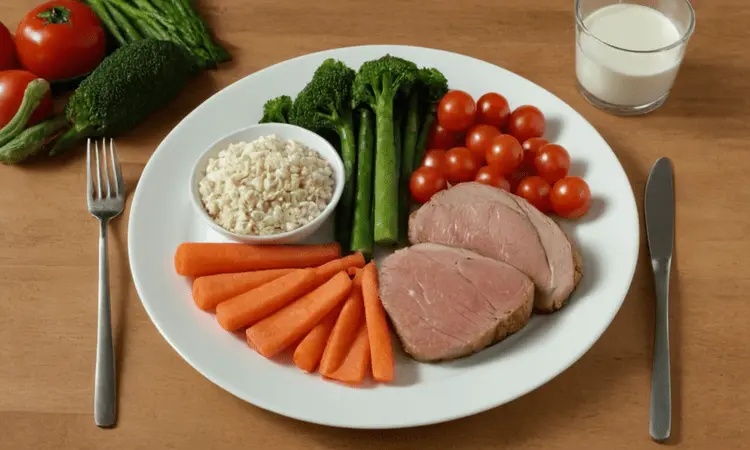If you’re exploring the semaglutide diet plan for weight loss, you may feel overwhelmed by all the information (or lack thereof). Finding clear, reliable guidance on maximizing your results can be a challenge.
Conflicting diet advice is everywhere, especially when you’re considering medication like semaglutide. You need a roadmap for success with a semaglutide weight loss diet.
Get ready to unlock the secrets of success! This guide is your roadmap to understanding the semaglutide diet plan. We’ll cover the best foods to eat on semaglutide, how to craft a semaglutide nutrition guide, and tackle those pesky side effects.
Discover how to create a meal plan for semaglutide that fuels your body and supports your weight loss journey.
Keys to Your Semaglutide Diet Plan
- Consult your doctor
- Prioritize whole, healthy foods
- Aim for balanced nutrition
- Manage potential side effects
- Stay active
- Think long-term success
Table of contents
Introduction

Everything You Need to Know About the Semaglutide Diet Plan
Struggling to manage your weight? Feeling frustrated with diets that don’t deliver? You may have heard the buzz about the semaglutide diet plan. But is this weight loss medication the answer you’ve been searching for?
Let’s dive in! Semaglutide is a type of medication called a GLP-1 receptor agonist. It works by mimicking a natural hormone in your body that helps regulate appetite and blood sugar levels.
This powerful effect can make it much easier to stick to a healthy diet and see those numbers on the scale start to drop.
However, it’s crucial to remember that semaglutide isn’t a magic bullet. To get the best possible results, you’ll need a solid weight loss plan. That’s where the semaglutide diet plan comes into play!
Is the Semaglutide Diet Plan Right For You?
Before you jump on the semaglutide bandwagon, it’s important to consult with your doctor. They can help you determine if this medication aligns with your health needs and weight loss goals. Generally, the semaglutide diet plan may be suitable if you:
- Have a high body mass index (BMI)
- Are struggling with weight-related health conditions
- Have tried other weight loss methods without success
Keep in mind, semaglutide works best when coupled with healthy lifestyle changes. Are you ready to make those changes? If so, this plan could help you achieve lasting weight loss success.
Let me know if you have any questions about the semaglutide diet plan! Feel free to leave a comment below or tag me on social media.
Did you know that consistent carbohydrate intake can enhance your semaglutide success? Learn how this simple strategy promotes stable blood sugar levels and supports your overall health goals…
Foundations of a Semaglutide-Friendly Diet
Prioritizing the Essentials: Macronutrients on the Semaglutide Diet
Think of your semaglutide diet plan like building a sturdy house. What are the core building blocks? Protein, complex carbohydrates, and healthy fats! Each plays a crucial role in keeping you satisfied and energized while supporting your weight loss goals.
- Protein Power: Protein is your diet’s superstar. It helps you feel full, builds muscle, and keeps your metabolism humming. Aim for lean sources like chicken, fish, beans, lentils, tofu, eggs, and low-fat dairy.
- Complex Carbs: Your Steady Energy Source: Don’t fear carbs! Choose complex carbohydrates like whole grains (brown rice, quinoa, oats), vegetables, and fruits. These provide sustained energy and valuable fiber.
- Healthy Fats: The Key to Satisfaction: Healthy fats are essential for feeling full and promoting good health. Opt for avocados, nuts, seeds, olive oil, and fatty fish.
Fuel Your Body: Foods to Include and Limit
So, what does this look like on your plate? Let’s break it down!
- Foods to Emphasize:
- Lean proteins: Aim for a variety at every meal
- Vibrant vegetables: Fill half your plate with all colors of the rainbow.
- Whole grains: Upgrade from refined grains.
- Legumes: Powerhouses of protein and fiber
- Fruits: Nature’s sweet treat in moderation
- Nuts and seeds: A satisfying, healthy snack
- Foods to Minimize:
- Processed foods: These are often packed with unhealthy fats, sugar, and sodium.
- Refined grains: Think white bread, white pasta
- Sugary drinks: Opt for water instead!
- Excessive saturated/trans fats: Choose healthier fats most of the time.
Is a completely “clean” diet necessary on the semaglutide diet plan? No! Aim for progress, not perfection. If you crave a treat, enjoy a small portion mindfully.
For dietary advice tailored to your needs and health conditions, consider working with a registered dietitian nutritionist.
Remember, semaglutide helps control appetite, but it’s not a magic bullet. Focusing on whole, nutritious foods is key. Ready to transform your plate? Share your favorite semaglutide-friendly meals in the comments!
Practical Strategies and Smart Eating for Semaglutide Diet Plan

Mindful Eating: Essential for Semaglutide Success
Ever feel like you’re on autopilot while eating, barely noticing the food? With the semaglutide diet plan, it’s time to tune in.
Mindful eating means paying attention to your body’s hunger and fullness cues. This can be a game-changer when it comes to managing your appetite on semaglutide.
How do you practice this? Slow down, take smaller bites, and really savor your meals. Put away the distractions – no phones or TV at the table! By being present with your food, you might find yourself surprisingly satisfied with smaller portions.
Staying Hydrated and Its Role in Weight Loss
Think water is boring? Think again! Staying hydrated is crucial on your semaglutide journey. Sometimes thirst can feel like hunger, leading to unnecessary snacking. Aim to drink enough so that your urine is a pale yellow color.
Carry a reusable water bottle and sip throughout the day.
Is upping your water intake enough? Absolutely not, but it’s a simple change that can have a big impact on how you feel, especially when adjusting to the semaglutide diet plan.
Making Meal Planning Easy
Meal planning might not sound exciting, but it’s a secret weapon for success with the semaglutide diet plan. Here’s why:
- Reduced impulsive choices: Prepped meals make healthy eating easy when willpower is low.
- Less food waste: Plan to use up ingredients before they go bad.
- Saves time: Batch cooking or meal prep on the weekend means less stress during the week.
Combating Side Effects and Staying Consistent
Managing Common Semaglutide Side Effects
Starting a new medication can be a bit bumpy, right? Semaglutide sometimes comes with side effects like nausea, bloating, or constipation. Is that enough to derail your whole weight loss effort? Absolutely not!
Let’s tackle these digestive hiccups head-on. Here are some strategies to keep you feeling your best on your semaglutide diet plan:
- Smaller, Frequent Meals: Break down your food intake to ease digestion.
- Ginger Power: This natural remedy can soothe nausea.
- Hydrate, Hydrate, Hydrate: Water keeps things moving smoothly.
- Fiber Up: Fruits, veggies, and whole grains prevent constipation.
If these tips don’t help, don’t hesitate to talk to your doctor. They might be able to adjust your dosage or suggest additional remedies.
Overcoming Barriers and Finding Support
Weight loss journeys aren’t always a straight line. Plateaus happen, motivation wanes – it’s totally normal! So, how do you stay consistent on your semaglutide diet plan?
Here’s the key: build a support system. A healthcare professional, like a registered dietitian on the team at the Academy of Nutrition and Dietetics (eatright.org), can customize a plan for you.
They can answer your questions and offer tailored solutions as your journey progresses. Plus, having someone in your corner makes a big difference!
Don’t underestimate the power of community either. Online groups or forums offer a safe space to share challenges, celebrate wins, and get inspired by others on a similar path.
Let’s Chat! Have you experienced any side effects with semaglutide? What are your favorite tips for staying motivated? Share in the comments below!
Beyond the Diet – Lifestyle Factors

Think of the semaglutide diet plan as a powerful tool. But will a tool build a house without someone to wield it? Lifestyle changes are the hands that shape your success!
The Power of Exercise with Semaglutide
Exercise and semaglutide go hand in hand. Is it necessary? No, but it significantly boosts your results! Consistent movement will:
- Increase the calories you burn
- Amplify your weight loss
- Support muscle building (great for metabolism!)
So, what kind of exercise is best? Choose activities you enjoy! Walking, swimming, weightlifting – anything that gets you moving regularly is fantastic.
Sleep, Stress, and Your Weight Loss Journey
Sleep and stress sound unrelated to food, right? Wrong! When you’re sleep-deprived or stressed out, your body craves quick energy – think sugary, fatty snacks. Plus, your self-control weakens.
Aim for 7-8 hours of quality sleep nightly. Find healthy stress-busters: meditation, a calming walk, or a chat with a trusted friend. Need more support?
Long-term Success after Semaglutide
The semaglutide diet plan is a temporary jumpstart. So, how do you maintain your results? By building sustainable habits! This means:
- Continuing to prioritize healthy foods
- Regular physical activity
- Ongoing stress management
- Seeking support when needed
Is it easy? Not always. But the reward of lasting health is beyond worth it!
Intrigued by the power of protein for weight loss and beyond? Explore how a high-protein diet can complement your semaglutide plan and unlock even greater results. Discover the science and strategies behind this muscle-building approach – click here!
Your Semaglutide Diet Plan Questions Answered
Focus on healthy, sustainable weight loss with your doctor’s guidance. Semaglutide aids weight loss, but rapid results aren’t the goal.
Calorie needs are individual. Talk to your doctor or a registered dietitian for a personalized plan.
Semaglutide isn’t for rapid weight loss. Aim for safe, gradual weight loss under your doctor’s supervision.
Your protein needs depend on several factors. Consult your doctor or a registered dietitian for the right amount for you.
While semaglutide can help, you’ll likely see the best results by combining it with healthy eating habits.
Talk to your doctor! They’ll help you decide if semaglutide is right for you.
Try visiting a registered dietitian nutritionist or exploring resources like the American Diabetes Association for healthy eating plans.
Some people experience nausea or digestive discomfort. These often improve over time.
A well-planned diet should provide everything you need. If you’re concerned, talk to your doctor or a dietitian.